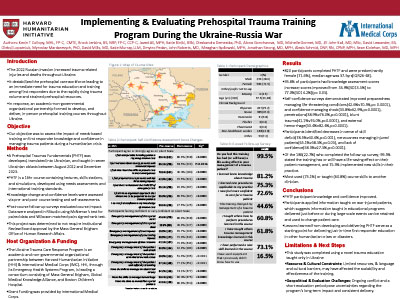ABSTRACTS
Implementing and Evaluating a Sustainable Prehospital Trauma Training Program During the Ukraine–Russia WarAuthor: Brock Jenkins, Kevin Collopy, Javed Ali, Oleskandra Demestka, Alona Goncharova, Michelle Gonnet, Myroslav Mardarevych, Dmytro Pedan, Alexis Schmid, and Sean Kivlehan | | Associate Authors:
Introduction: Prehospital Trauma Fundamentals (PHTF) has been taught in Ukraine by international instructors in response to the ongoing need for prehospital trauma training following the full-scale Russian invasion on Ukraine in 2022. High-performing students from these courses were selected to complete a training-of-trainers course and then mentored by international instructors while teaching additional courses. Objective: To determine if courses taught by newly trained Ukrainian instructors were effective. Methods: Instructor candidates were identified from high-performing course participants. The candidates completed a training-of-trainer course and were mentored by international instructors to become certified PHTF instructors. The new instructors initially cotaught with international instructors using bidirectional interpretation, and then taught independently with supportive observation. Knowledge and confidence levels of participants were assessed through pre- and postcourse testing and self-assessments, with follow-up surveys evaluating long-term impact. Data were analyzed using McNemar’s test and the Wilcoxon matched-pairs signed-rank test. This project did not require Institutional Review Board approval from the Mass General Brigham Office of Human Research Affairs. Results: A total of 178 participants completed the Ukrainian-led PHTF courses. Knowledge scores increased for 94.2% of participants, from 61.6% (SD = 13.5%) to 81.6% (SD = 12.8%) (p < .05). Self-confidence surveys of 139 participants showed improved preparedness for managing life-threatening conditions (49.6% vs. 83.5%, p < .0001) and difficulty breathing (38.9% vs. 79.1%, p < .0001) and increased confidence in managing injured adults (56.1% vs. 82.7%, p < .0001), children (23.0% vs. 54.0%, p < .0001), shock (41.7% vs. 77.0%, p < .0001), penetrating injuries (40.3% vs. 85.6%, p < .0001), blunt trauma (46.8% vs. 85.6%, p < .0001), and external hemorrhage (53.4% vs. 82.4%, p < .0001). Conclusion: PHTF participant knowledge and confidence improved significantly with Ukrainian-led instruction. This highlights the effectiveness of the identification, training, and mentorship of these instructors, suggesting that educational programs delivered before or during large-scale events can be retained to build sustainable and locally led programming. The insights from the PHTF program provide a framework for implementing just-in-time first responder education in future humanitarian crises.
|

